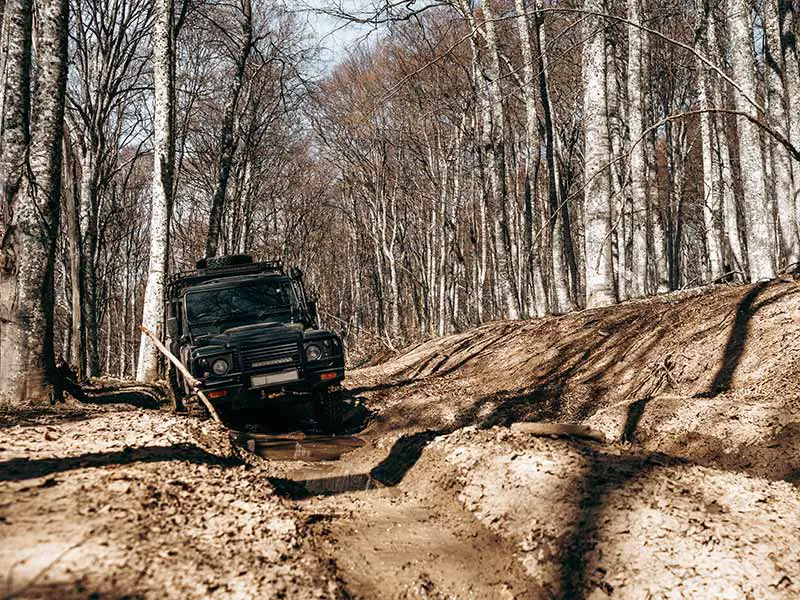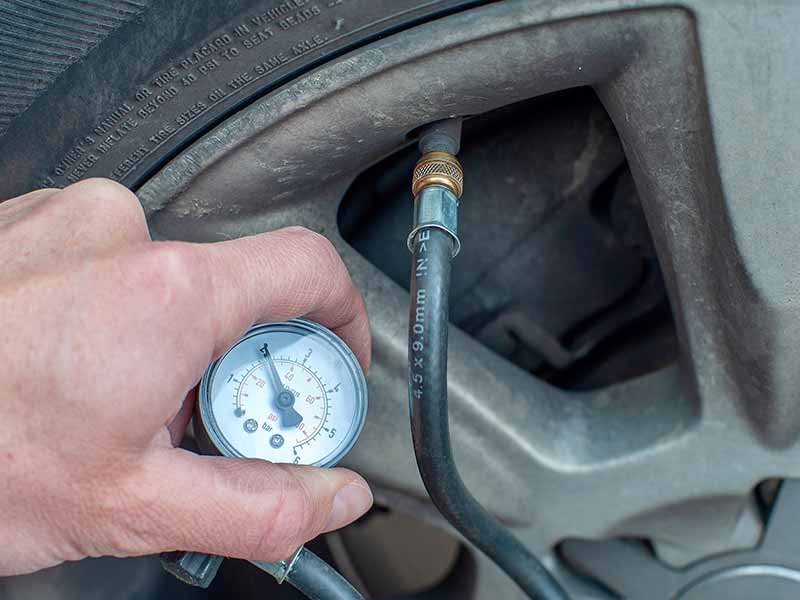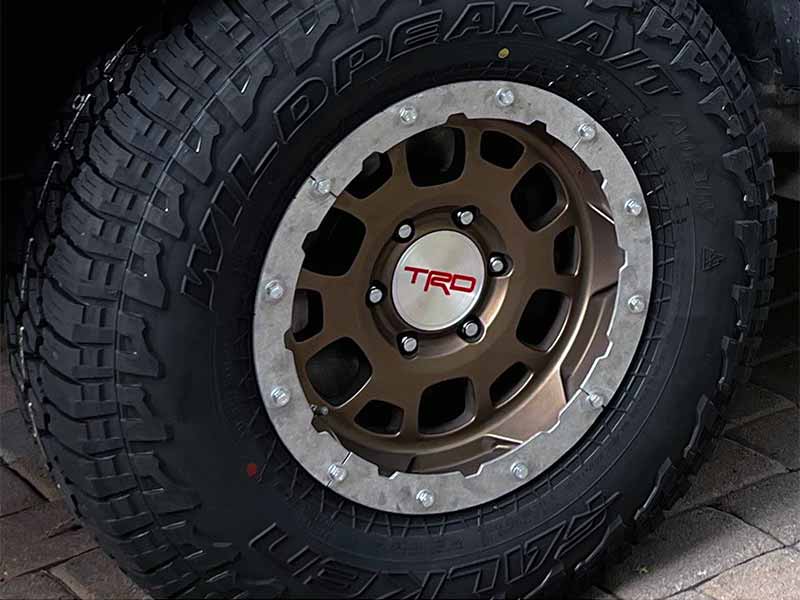Are you ready to tackle the rugged trails and maximize your off-roading adventure? Airing down your tires can significantly boost your vehicle’s traction and handling on uneven terrains. But what if your rig isn’t equipped with beadlocks?
Airing Down Without Beadlocks
Airing down without beadlocks increases the risk of tire de-beading, yet alternatives like internal beadlock systems and run-flat inserts can help maintain tire integrity at lower pressures.
In this article, we delve into the intricacies of airing down tires for off-roading without beadlocks, covering everything from the benefits and risks to a step-by-step guide and safety best practices.

Beadlock Wheels
Understanding Tires and Their Role in Off-Roading
Off-roading is an exhilarating experience that demands not just skill and courage but also a deep understanding of your vehicle’s capabilities, especially your tires. Tires are the critical link between your vehicle and the terrain. They affect everything from traction to vehicle control and even the comfort of your ride. Let’s dive into the components of tires that matter most in off-roading and how tire pressure plays a pivotal role in navigating rough terrains.
Tire Basics for the Off-Roader
- Tread: This is the part of the tire that makes contact with the ground. The deeper and more aggressive the tread, the better the tire can grip uneven surfaces.
- Sidewalls: These are the sides of the tire. In off-roading, tires with strong sidewalls are preferred as they are less prone to damage and can perform better at lower pressures.
- Air Pressure: The amount of air in your tires affects their shape, size, and how they interact with the ground. Adjusting air pressure is a crucial technique in off-roading to improve grip and reduce the likelihood of punctures.
How Tire Pressure Affects Your Off-Road Experience
Manipulating tire pressure is a technique as old as off-roading itself. Here’s why it matters:
- Increased Traction: Lowering the air pressure increases the tire’s footprint (the area of tire touching the ground), which enhances grip on soft surfaces like sand, mud, or snow.
- Improved Ride Comfort: Softening the tires by reducing air pressure allows them to absorb more of the bumps and jolts you encounter on rough trails.
- Control and Flexibility: At lower pressures, tires can conform to the terrain, providing more steady and controlled handling.
The Fine Balance
While airing down provides numerous benefits, it’s not without risks. Without beadlocks, there’s a chance the tire could slip off the rim (de-beading) if the pressure is too low. This is where understanding the right pressure for your vehicle and terrain is vital. You want enough deflation to increase traction and comfort but not so much that you risk tire damage or de-beading.
Deciding When to Deflate
Before you head off into the wild, consider:
- Type of Terrain: Soft, sandy terrains might require lower pressure than rocky or hard-packed trails.
- Weight of Vehicle: Heavier vehicles may need a slightly higher pressure to avoid de-beading.
- Tire and Rim Size: Larger tires and rims can sometimes allow for lower pressures.
Practical Steps and Tips
When considering deflating your tires, always keep these tips in mind:
- Know Your Limits: Understand the lowest safe pressure for your specific tires and vehicle.
- Check Regularly: Always monitor tire pressure during and after deflation, especially if you’re not using beadlocks.
For a more comprehensive guide on when and how to adjust your tire pressure for various off-roading scenarios, explore our detailed insights on when to deflate tires for off-roading.

Fake Beadlocks
The Risks and Benefits of Airing Down Without Beadlocks
Airing down, or reducing the air pressure in your tires, is a common practice among off-roaders seeking to improve their vehicle’s traction and comfort on rough trails. However, doing so without the support of beadlocks comes with its own set of risks and rewards. Let’s delve into what you gain and what you must watch out for when you decide to air down in the wild.
Benefits of Airing Down
Airing down is not just a trick of the trade; it’s an essential strategy for any serious off-roader. Here are the benefits:
- Enhanced Traction: As the tire pressure decreases, the contact area between the tire and the ground increases, significantly improving traction especially in sand, mud, or snow.
- Smoother Ride: Lower tire pressures allow the tires to absorb more of the uneven terrain, leading to a noticeably smoother ride over rocks, roots, and ruts.
- Better Control: A softer tire can conform to obstacles, providing greater stability and control when navigating through challenging terrains.
Risks of Not Using Beadlocks
While beadlocks are not always necessary, they do provide an extra layer of security when airing down. Here are the risks of airing down without them:
- De-beading: The most significant risk is the tire completely separating from the rim, known as de-beading, which can leave you stranded and damage the tire and wheel.
- Increased Wear and Tear: Operating at lower pressures without beadlocks can stress the tire’s structure and lead to increased wear or even failure.
- Loss of Control: If the tire pressure is too low, it can lead to unpredictable vehicle handling, potentially resulting in loss of control.
Navigating the Risks
Understanding and mitigating the risks associated with airing down without beadlocks is crucial for a safe off-roading experience.
- Know Your Terrain and Vehicle: Different terrains and vehicles have different sweet spots for tire pressure. Knowing yours is key to avoiding issues.
- Never Go Too Low: Always keep your tire pressure within a safe range to prevent de-beading and maintain control.
- Regular Inspections: Frequently inspect your tires for any signs of damage or abnormal wear, especially if you frequently air down.

Step-by-Step Guide to Airing Down
Reducing your tire pressure, or airing down, is a technique off-roaders use to increase the tire’s contact area with the ground, thus enhancing traction and managing rough terrains more effectively. While the concept is simple, the execution requires attention to detail and understanding of the process to ensure safety and effectiveness. Here’s a step-by-step guide to airing down your tires properly, especially when beadlocks are not part of your setup.
Equipment Needed
Before you start, ensure you have the right tools. Here’s what you’ll need:
- Air Gauge: A reliable air gauge to accurately measure tire pressure.
- Portable Air Compressor: To re-inflate the tires once you’re back on regular roads or need to adjust the pressure.
- Valve Stem Tool: Optional but useful in quickly releasing air from the tires.
Steps to Airing Down
Follow these steps to air down your tires safely and effectively:
- Check Initial Pressure: Start by checking the current pressure in all your tires using the air gauge.
- Determine Target Pressure: Decide the optimal pressure based on your vehicle, tire type, and terrain. This is typically between 15-20 psi for many off-road situations but may vary.
- Deflate Tires Gradually: Use the valve stem tool or simply press on the valve core to release air. Check the pressure regularly to avoid going too low.
- Inspect Tire Footprint: As you deflate, observe the tire’s contact area with the ground. A larger, flatter footprint indicates increased traction.
- Ensure Even Deflation: Make sure all tires are deflated to the same pressure to maintain balance and control of the vehicle.
Tips to Determine the Optimal Pressure
- Consider Vehicle Weight: Heavier vehicles might require slightly higher pressures to prevent the tires from de-beading.
- Account for Temperature: Tire pressure can change with temperature. What’s perfect in the morning might be too low or high in the afternoon heat or cold.
- Experience Counts: The more you off-road, the better you’ll understand how your vehicle handles different pressures in various terrains.
Re-inflating Your Tires
Once you’re done off-roading, or if you need to adjust the pressure:
- Stop and Check: Once back on firmer ground, stop and check all tires.
- Use Your Portable Air Compressor: Attach the compressor to each tire and inflate back to the standard road-going pressure.
- Double-Check Pressure: Ensure all tires are evenly and adequately inflated for safe road travel.

Staun Tire Defaltors
Alternatives to Beadlocks
While beadlocks are a popular choice for serious off-roaders to secure the tire to the rim at lower pressures, they are not the only option. Whether due to cost, legality, or personal preference, you might seek alternatives that still allow you to air down safely and effectively. Here’s a look at some alternative methods and technologies that can help maintain tire integrity and traction without beadlocks.
Internal Beadlock Systems
Internal beadlock systems are one alternative that offer similar benefits without some of the drawbacks of external beadlocks:
- How They Work: These systems use an internal bladder or ring that expands to hold the tire against the rim from the inside.
- Pros: Often easier to install and may be more street-legal in areas where traditional beadlocks are not.
- Cons: Can be expensive and still require professional installation and maintenance.
Run-Flat Inserts
Run-flat technology isn’t just for maintaining control during a puncture; some systems can help keep the tire on the rim at lower pressures:
- How They Work: These inserts support the tire’s structure, allowing it to maintain shape even with significantly reduced air pressure.
- Pros: Adds a layer of puncture resistance and can be a safety feature even during regular driving.
- Cons: Increases the overall weight of the tire and wheel assembly and may affect ride quality.
Air-Locking Differentials
While not a direct alternative to beadlocks, air-locking differentials can enhance off-road performance in a way that complements airing down:
- How They Work: These systems allow you to lock or unlock the differential with the flip of a switch, providing better traction in challenging conditions.
- Pros: Improves off-road capability and can be used in conjunction with aired-down tires for superior performance.
- Cons: More about enhancing traction than tire retention and requires a significant modification to your vehicle.
Double Beading
Some tires are designed with a double beading feature that offers a more secure grip on the rim:
- How They Work: These tires have an extra bead on the inner lip, increasing the contact area with the rim.
- Pros: Provides a more secure fit, reducing the risk of de-beading at lower pressures.
- Cons: Tire choices may be limited and can be more expensive.

Safety Tips and Best Practices
Venturing off-road with aired-down tires, especially without beadlocks, requires a vigilant approach to safety and maintenance. Understanding how to manage your tires’ pressure and condition not only prevents accidents but also extends the life of your tires. Here’s a collection of safety tips and best practices to ensure that your off-roading adventures are as safe as they are thrilling.
Regularly Monitor Tire Condition
Keeping a close eye on your tires is crucial, particularly when airing down:
- Visual Inspections: Before and after each trip, inspect your tires for cuts, bulges, or any signs of wear and damage.
- Pressure Checks: Regularly check your tire pressure during your adventure to ensure it remains within a safe range.
- Post-Adventure Care: After off-roading, give your tires a thorough clean to remove any debris and conduct a detailed inspection.
Know When to Air Back Up
Understanding the right time to reinflate your tires is just as important as knowing when to air them down:
- Transitioning to Pavement: Always reinflate to the recommended pressure before hitting paved roads to ensure safety and tire longevity.
- Adjusting to Terrain: If the terrain becomes less challenging or you’re increasing speed, consider inflating the tires to suitable levels for those conditions.
Equip for Emergencies
Be prepared for the unexpected with the right tools and knowledge:
- Carry a Repair Kit: Include tire plugs, patches, and a portable air compressor in your off-road kit.
- Learn Tire Repair: Know how to fix a flat or reseat a tire bead in case of emergencies.
- Emergency Communication: Have a means to call for help if you’re unable to repair a tire issue on the trails.
Best Practices for Off-Road Tire Safety
Incorporate these best practices into your routine to maintain safety and performance:
- Start with Quality Tires: Choose tires known for their durability and suitability for off-road conditions.
- Avoid Excessive Speeds: Especially when tires are aired down, high speeds increase the risk of damage and accidents.
- Balance and Rotate Regularly: Proper maintenance extends tire life and prevents uneven wear.
Resources
Below are some links you may find helpful when learning about tires:
- Your Ultimate Guide to Off-Roading Tire Pressure – JACO
- How Much To Air Down When Off-Roading – Rhino USA
Final Thoughts
Navigating the off-road trails requires not just courage and skill but also a deep understanding of your vehicle, especially your tires. Airing down is a vital technique for enhancing traction and handling, but it must be done wisely, particularly without the security of beadlocks.
We’ve explored the benefits, risks, and methods to ensure you’re equipped with the knowledge for a safer, more enjoyable off-roading experience. Remember, the most successful off-road adventurers are those who prepare thoroughly and tread wisely.
Good luck and happy motoring.




